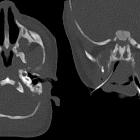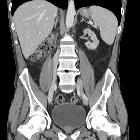CHARGE syndrome


CHARGE syndrome is an acronym that classically describes a combination of head and neck, cardiac, CNS and genitourinary disorders:
- C: coloboma
- H: heart defects (congenital heart disease)
- A: atresia (choanal)
- R: retardation of growth and development
- G: genital and/or urinary abnormalities
- E: ear abnormalities and/or deafness
Clinical presentation
CHARGE syndrome is usually suspected at birth once multiple congenital abnormalities are identified.
Diagnosis
The diagnosis of CHARGE syndrome can be made on clinical grounds :
- definite CHARGE syndrome: four major characteristics or three major characteristics and three minor characteristics
- possible/probable CHARGE syndrome: one-to-two major characteristics and several minor characteristics
Major criteria
- coloboma (~85%)
- choanal atresia/stenosis (~55%) (or cleft palate)
- cranial nerve dysfunction, e.g. facial palsy (~40%), dysphagia (~80%)
- CHARGE syndrome ear (some or all of the following)
- atretic outer ear
- ossicular chain malformation
- Mondini malformation
- absent/hypoplastic semicircular canals
Minor criteria
- urogenital abnormalities
- kidney
- penis
- hypospadias
- penile agenesis
- scrotum/testicles
- bifid scrotum
- cryptorchidism
- vaginal atresia
- uterine atresia
- congenital heart disease
- short stature
- cleft palate +/- lip
- esophageal atresia / tracheo-esophageal fistula (~15%)
- characteristic facies
- developmental delay
Associations
- microphthalmia/anophthalmia
- intra-uterine growth restriction (IUGR)
- congenital renal anomalies
- coronal clival cleft
- agenesis/hypoplasia of semicircular canals (highly characteristic)
Pathology
CHARGE syndrome is thought to occur due to a disturbance in embryonic differentiation ~35 to 45 day of gestation.
Genetics
Most cases are sporadic but there are occasional autosomal dominant forms. Approximately two-thirds of cases are caused by a defect in the CHD7 gene on chromosome 8 .
Treatment and prognosis
The prognosis is variable depending on the extent of defects. In sporadic forms, the risk of recurrence is at ~1%.
History and etymology
This constellation of pathology was initially described by B D Hall and independently by H M Hittner in 1979. The term "CHARGE" was first coined by R A Pagon to describe an association between the symptoms and subsequent work isolated a common genetic defect seen in 60% of individuals: the CHD7 defect.
Siehe auch:
- Herzfehler
- Choanalatresie
- Ösophagusatresie
- angeborene renale Anomalien
- ösophagotracheale Fistel
- Kolobom
- Mikrophthalmus
- orofaziale Spalten
- intra-uterine growth retardation (IUGR)
und weiter:

 Assoziationen und Differentialdiagnosen zu CHARGE-Syndrom:
Assoziationen und Differentialdiagnosen zu CHARGE-Syndrom:







